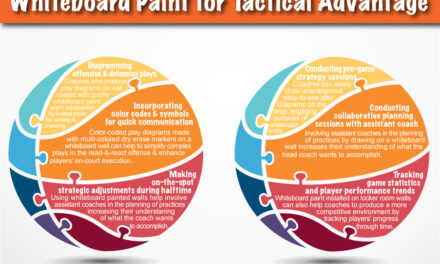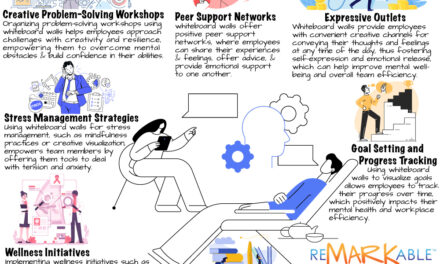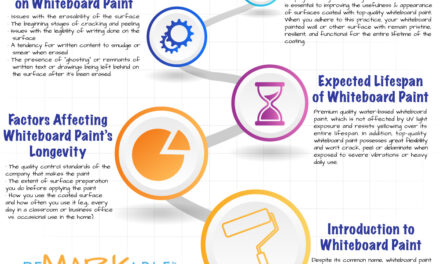More Advantages of Using High-Quality Whiteboard Paint including a detailed explanation on the question of How long does whiteboard paint last? and the ten-year answer you should hear.
Durability – How long does whiteboard paint last?
Over the long run, besides being exceptionally safe for human health and the planet, water-based coatings like our high-quality whiteboard paints are unique in that they have unsurpassed commercial-grade durability, maintaining their easy dry-erase quality for ten-plus years indoors before having to be replaced. In addition, if they’re well maintained and undergo a normal amount of use, we guarantee that our surfaces won’t undergo cracking, peeling, staining, discoloration, or fading for ten-plus years.
Paint and coating manufacturers employ a vast range of techniques and equipment to gauge the quality of their products. Testing is done for properties such as viscosity, or the thickness of a paint or coating, density (weight per gallon), and compliance with safety guidelines set by the Environmental Protection Agency (EPA), which involve the levels of harmful chemicals present in a paint or coating. You can be sure that each batch of our premium whiteboard paints undergoes a great number of such quality-control tests multiple times before being placed in containers and shipped to our customers. This rigorous post-production assessment process ensures that our clients receive only the most durable and highest quality coatings, which will last ten or more years when installed and used according to instructions, and provide easily erased, smudge-free, and abrasion-resistant surfaces for countless creative, business, and instructional applications.
Low Odor Whiteboard Paint
Unlike most whiteboard wall coatings on the market, high-end ReMARKable whiteboard coatings are virtually odor-free, being formulated with extremely small amounts of chemicals known as volatile organic compounds (VOCs). Thus, after application, your freshly coated dry erase canvas will produce few if any fumes or odors while drying and also during future use throughout its lifetime. And you won’t need to be concerned about eliminating, covering up, or reducing a strong, unpleasant fresh-paint aroma in your workplace either. Water-based whiteboard paints such as our products use only water to disperse the resin they contain. This high water content makes our paints more eco-friendly than other types such as those with an epoxy base. Waterborne dry-erase coatings contain far fewer VOCs than other kinds of coatings and are also less flammable. A less combustible formula is beneficial because it’s much safer, and also decreases the amount of hazardous waste that a product creates. Moreover, such paints are practically odor-free, since their main ingredient is water. Thus, we stipulate that water-based formulas be used for all of our coatings.
Dangerous, smelly fumes do not equal good quality. In fact, they can be a sign of poor quality. The epoxy-based dry-erase coatings manufactured by some of our competitors are especially problematic in this respect.
Fumes
The most dangerous aspects associated with epoxy-based paints are the fumes they give off both during and after application. When painting with epoxy paint, gases are emitted that can cause a number of serious health problems, so it’s necessary to make sure the area in which they’re being applied is well ventilated, with fans running and windows left open to let the fumes escape. Those applying the paint are also advised to take frequent breaks to avoid inhaling the fumes. Some potential dangers associated with epoxy-based paints involve breathing their vapors and allowing the paints to come in contact with the skin.
Most symptoms resulting from inhaling epoxy fumes involve inflammation and irritation of the nose, throat, and lungs. Repeated and high exposure to these fumes can result in allergic reactions and asthma. Thus, those who apply epoxy-based paints need to make sure the areas they work in are well ventilated.
Skin Contact
Another potential danger associated with epoxy-based paints relates to the skin. Some people have strong allergic reactions when epoxy-based paints come into contact with their skin, so if this occurs, the epoxy needs to be cleaned off as soon as possible. If you get any on your skin, be sure to clean it off in a timely manner. As one website on epoxy-related hazards states, “You should try to never get epoxy on your skin. Wear gloves if you have to.”
None of these risks are present when you use our premium dry-erase coatings, as they are extremely low in VOCs and odors, meaning that no harmful chemicals or fumes get into the atmosphere during or after their application. Our coatings are thus extremely kind to the environment and provide an example for other manufacturers to follow in the industry’s efforts to meet growing consumer demand and comply with government regulations on the manufacture of eco-friendly paints and coatings.
Headache-Free
Low-end dry erase paints often require staff to clear out of the office for several days or else they will suffer terrible headaches from the presence of the many VOCs given off by the paints’ ingredients. VOCs are extremely hazardous to human health. Based on data from the United States Environmental Protection Agency (EPA), VOCs trigger inflammation of the eyes, nose, and throat, recurring headaches, queasiness, and possible kidney, liver, and brain impairment. In contrast, our premium dry-erase coatings are manufactured with non-toxic, low odor components, and are among the first dry erase paint products to conform to the safety guidelines of Leadership in Energy and Environmental Design, a world-renowned green building-certification program. So you won’t have to relocate your office and team while our product is applied and as it cures during its brief 48-hour drying period.
By comparison, most of our competitors’ epoxy-based paints have a drying time of three to seven days, and throughout this period the area that’s been painted often needs to be vacated due to the hazardous gases given off as the paint cures. For this reason, companies or organizations have to find temporary spaces in which to work, requiring precious time, energy, and resources that could be more profitably spent in doing business at their regular location.
Some of the disadvantages of temporarily shutting down your workplace include (1) extra expenses incurred by your company, organization, or school; (2) inconvenience to yourself, your team members, and your customers; (3) possible technical issues and lack of IT support; (4) awkward interactions among employees in a temporary work area; and (5) adverse effects on employee privacy.
Such relocation is unnecessary when our top-quality whiteboard coatings are applied; in fact, your office team can even remain in the workplace and continue doing business while our products are being installed.
Easy Cleanup
After application, our high-quality water-based dry erase paint requires only soap and water for cleanup. A combination of warm water and gentle soap suds is the ideal cleaning solution for you, your paint rollers, your roller trays, and other items. Prepare some soapy water, pour it into a clean container, clean everything off as you would after working with any other waterborne paint, and follow up with a clear water rinse.
However, epoxy-and-solvent-based paints are another story. Cleaning up epoxy resin or mixed epoxy residue requires the use of lacquer thinner, acetone or isopropyl alcohol, and adequate ventilation is mandatory to eliminate the highly toxic fumes given off by these liquids. Also, during the cleanup, the safety guidelines written on the containers for these solvents must be followed. Some of the health issues these chemicals can cause include the following: 1) lacquer thinner – conjunctivitis; gastric disturbances; dizziness; headaches; fatigue; nausea; heart palpitations; kidney, liver, pancreas, and brain damage; and visual impairment/blindness; (2) acetone – nose, throat, lung and eye irritation; headaches, dizziness, confusion, rapid pulse, nausea, vomiting, and unconsciousness/coma; (3) isopropyl alcohol – inhalation can be toxic.
Given all of the above-mentioned hazards related to the application, drying, and cleanup of epoxy-based dry erase coatings, it’s obviously far safer for you, your staff, your clients, and the environment to apply our low odor, water-based whiteboard coatings that are free of toxic fumes during application, drying, and later use.

























































































![ReMARKable’s Winter Sale is Here! [25% Off + Free Shipping]](https://www.remarkablecoating.com/wp-content/uploads/2018/01/Red-Tag-Winter-Fashion-Facebook-Post-1-440x264.png)















![Drive Your Organization Into Openness and Watch it Expand [20% Off Whiteboard Paint]](https://www.remarkablecoating.com/wp-content/uploads/2016/04/Drive-Your-Organization-Into-Openness-and-Watch-It-Expand.-1-440x264.jpg)

![30% Off St Patrick’s Day Sale! [Details Inside]](https://www.remarkablecoating.com/wp-content/uploads/2016/03/Glorious-1-440x264.png)


![Giant Leaps Forward Require Big Spaces. [Leap Year Sale Event!]](https://www.remarkablecoating.com/wp-content/uploads/2016/02/Giant-Leaps-ForwardRequire-Big-Spaces-440x264.jpg)

















![ReMARKable Summer Sale 2018 [28% Off Whiteboard Paint]](https://www.remarkablecoating.com/wp-content/uploads/2018/06/Blue-Simple-Line-Beach-Facebook-Post-1-440x264.png)



































































































































































































0 Comments